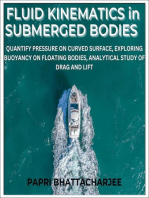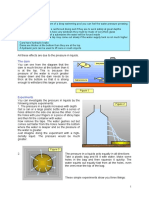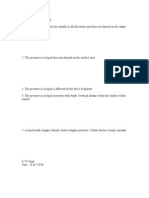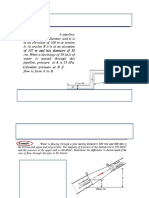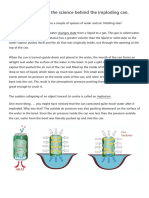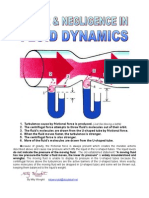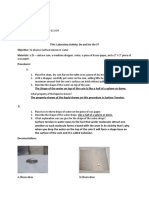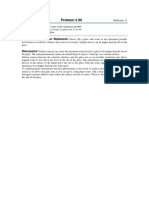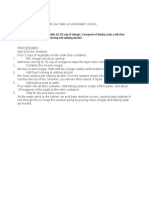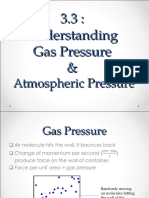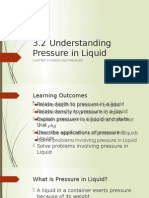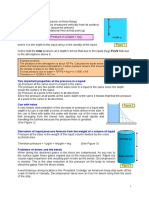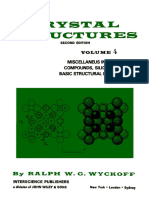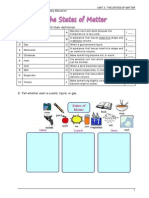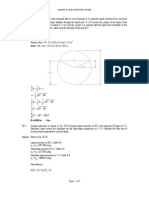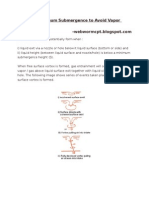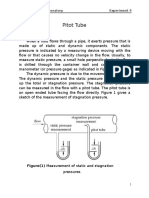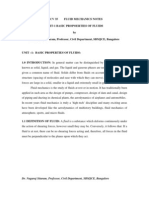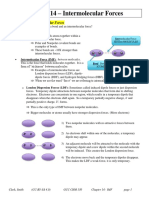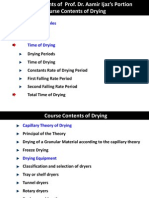Professional Documents
Culture Documents
Preasure Exerted by Liquids Class Notes PDF by Sahaj Ahuja
Uploaded by
Sahaj Ahuja0 ratings0% found this document useful (0 votes)
37 views7 pagesOriginal Title
Preasure exerted by liquids class notes pdf by sahaj ahuja
Copyright
© © All Rights Reserved
Available Formats
PDF, TXT or read online from Scribd
Share this document
Did you find this document useful?
Is this content inappropriate?
Report this DocumentCopyright:
© All Rights Reserved
Available Formats
Download as PDF, TXT or read online from Scribd
0 ratings0% found this document useful (0 votes)
37 views7 pagesPreasure Exerted by Liquids Class Notes PDF by Sahaj Ahuja
Uploaded by
Sahaj AhujaCopyright:
© All Rights Reserved
Available Formats
Download as PDF, TXT or read online from Scribd
You are on page 1of 7
Pressure Exerted by Liquids
Last Updated on April 6, 2023 By Mrs Shilpi Nagpal
Question 1 How does the pressure of a liquid depends on
its depth. Explain?
Question 2 What conclusion do you get from the
observation that a fountain of water is created at the leaking
joint of pipes of the main water supply line?
Question 3 Liquids exert pressure on the wall of contain.
Explain?
Question 4 Liquid exert pressure on the bottom of the
container. Explain?
Question 5 liquid exerts pressure on the walls of its
container. Explain?
Question 6 liquid exerts equal pressure at the same depth.
Explain?
All the liquids exert pressure on the base or bottom and
walls of their container. All the liquid have weight.
When we pour liquid into a vessel, then the weight of liquid
pushes down on the base of the vessel producing a
pressure.
The liquid exerts pressure on the base of the vessel.
The pressure exerted by a liquid changes with depth in the
liquid. The pressure exerted by a liquid increases with
increasing depth inside the liquid. The pressure exerted by
a liquid is small just under the surface of the liquid. But as
we go we deeper in a liquid the pressure of liquid increases.
As the depth of liquid increases the weight of liquid column
pushing down from above increases and hence the
pressure also increases.
Activity: The pressure of liquid increases with depth
A tall vessel has short and thin tubes tted at di erent
depth from the top of vessel. The three tubes are of equal
diameters and corks are tted into them. The vessel is lled
with water and then all the corks are removed quickly. On
removing the corks the water from uppermost tube is found
to travel the shortest distance from the base of the vessel,
the water from middle tube goes a little farther away
whereas water from the lowermost shoots out farthest all.
The depth of water near uppermost tube is small so the
water comes out from uppermost tube with smaller
pressure and falls near the bottom of the vessel. The depth
fi
fi
ff
fi
of water near middle tube is greater so the water comes out
with greater pressure from middle tube and falls farther
away from the base of vessel. The depth of water near
lowermost tube is the greatest so the water comes out of
lowermost tube with the greatest pressure and goes
farthest from the vessel. As the depth of water increases
the pressure of water gradually increases.
The greater the depth of a point in a liquid, the greater is
the pressure.
Liquids also exert pressure on the walls of the vessel in
which they are stored. The sideways pressure exerted by
liquids also increases with the depth of the liquid. The
sideways pressure of a liquid on walls of a vessel is almost
zero at its surface. As the depth of liquid increases the
sideways pressure on the walls of the vessel gradually
increases and it becomes maximum near the bottom of the
vessel.
The wall of a dam is made thicker at the bottom so as to
tolerate very high sideways pressure exerted by deep water
stored in the reservoir of dam.
Activity : Liquid exert pressure on the bottom of its
container which depends on the height of its column
Take a transparent plastic pipe. Also take a thin sheet of a
rubber. Stretch the thin rubber sheet and tie it tightly over
one end of the plastic pipe. The plastic pipe is the container
which has stretchable bottom made of a thin rubber sheet.
keeping the pipe vertical, let us pour some water in the pipe
from the top .We will nd that on pouring water in the pipe,
the rubber sheets tied to its bottom stretches and bulges
out. The bulging out of rubber sheet demonstrates that the
water poured in pipe exerts a pressure on the bottom of its
container. This is because the bottom of container is made
of a exible, thin rubber sheet which can get stretched by
the pressure exerted by water to form a buldge. Now pour
some water in the plastic pipe so that height of water
column in the pipe increases. As the height of water column
increases the bulge in the rubber sheet also increases
showing that the pressure of water on the bottom of its
container has increased. Greater the height of water column
fl
fi
in the pipe greater will be the bulge in its rubber sheet
bottom.
We conclude that:
(1) A liquid exerts pressure on the bottom of its container.
(2) The pressure exerted by a liquid depends on the height
of the liquid column.
Activity: A liquid exerts pressure on the walls of its
container
Take a plastic bottle. Fix a small glass tube above the
bottom of the plastic bottle. We should seal the joint of
glass tube with plastic bottle by using molten wax so that
water does not leak from the joint. Tie a thin sheet of rubber
tightly on the open end of glass tube. Now ll half of plastic
fi
bottle with water. On lling water, the rubber sheet tied to
the mouth of glass tube gets stretched and bulges out. The
bulging out of rubber sheet tied to the glass tube xed in
the wall of plastic bottle demonstrates that water present in
plastic bottle exerts pressure on the walls of the bottle. It is
the sideways pressure exerted by water which in ates the
thin rubber sheet forming a buldge. If we pour more water
in the plastic bottle to increase depth, we will see that the
bulge in the rubber sheet increases. This indicates that the
pressure exerted by water increases with increasing depth.
(1) The pressure exerted by a liquid on the walls of
container increases with increasing depth.
(2) A liquid exerts pressure on the walls of its container.
Activity: A liquid exerts equal pressure at the same
depth
Take a plastic bottle. Make 2 small holes of equal size on
the two opposite sides of the plastic bottle some distance
above the bottom of the bottle. The holes should be at
fi
fl
fi
exactly the same height from the bottom of the plastic
bottle. Now ll the bottle with water. The two jets of water
coming out of the two holes fall at the same distance away
from the base on its either side. The two jets of water can
fall at equal distance on the two sides of the bottle only if
the pressure of water at the depth of 2 holes in the bottle is
equal.
We conclude that
(1) A liquid exerts pressure on the walls of its container.
(2) A liquid exerts equal pressure at the same depth.
The formation of fountains of water from the leaking pipes
of water supply pipeline tells us that water exerts pressure
on the walls of its container.
fi
You might also like
- Martin Gardner's Science Magic: Tricks and PuzzlesFrom EverandMartin Gardner's Science Magic: Tricks and PuzzlesRating: 5 out of 5 stars5/5 (2)
- Pressure in LiquidsDocument2 pagesPressure in LiquidsFaran AzeemNo ratings yet
- National Level SF 2020Document2 pagesNational Level SF 2020Priya MuruganNo ratings yet
- Diffusion and Surface TensionDocument2 pagesDiffusion and Surface TensionMuhammad MosaNo ratings yet
- Bab3,4,5 (Fizikt4)Document53 pagesBab3,4,5 (Fizikt4)Mohd Sufian TokimanNo ratings yet
- Drinking Straw: Crushing Can ExperimentDocument1 pageDrinking Straw: Crushing Can ExperimentvedasewahNo ratings yet
- The Pressure1Document5 pagesThe Pressure1Liliya TNo ratings yet
- Physics Project - Make Heron's FountainDocument8 pagesPhysics Project - Make Heron's FountainPoonam YadavNo ratings yet
- Cartesian Diver Experiment and LinereportDocument7 pagesCartesian Diver Experiment and LinereportMarvin Carl GranadaNo ratings yet
- Flushing Cistern AssingnmentDocument7 pagesFlushing Cistern AssingnmentLenson Mhango100% (1)
- Sains Chapter 8Document18 pagesSains Chapter 8Avinash PeterNo ratings yet
- Name: Yasir Islam Lab: #1 Date: 6/10/2021 Subject: Physice Titile: Pressure AIM: To Determine That Pressure Varies With High. ApparatusDocument2 pagesName: Yasir Islam Lab: #1 Date: 6/10/2021 Subject: Physice Titile: Pressure AIM: To Determine That Pressure Varies With High. ApparatusYasir IslamNo ratings yet
- 3 Forces and PressureDocument24 pages3 Forces and PressureAbdiwahabSaedIbrahimNo ratings yet
- How Does A Siphon Work?Document8 pagesHow Does A Siphon Work?Govarthanan GopalanNo ratings yet
- Home Made Wáter Fountain - Zoat Martinez 3thDocument7 pagesHome Made Wáter Fountain - Zoat Martinez 3thLesvia EstradaNo ratings yet
- Capilarity in SoilDocument3 pagesCapilarity in Soilduncan ochamiNo ratings yet
- Siphon Design TheoryDocument8 pagesSiphon Design TheoryNikola DraženovićNo ratings yet
- 3.2 Pressure in LiquidsDocument3 pages3.2 Pressure in LiquidsHeng ChungNo ratings yet
- CHAPTER 11 FORCE AND PRESSURE - Docx 3Document4 pagesCHAPTER 11 FORCE AND PRESSURE - Docx 3Amaira KalsiNo ratings yet
- Fluid 4Document8 pagesFluid 4يوميات عبداللهNo ratings yet
- REPORT SHEET Properties and Purification of Water PDFDocument12 pagesREPORT SHEET Properties and Purification of Water PDFAbegail CantonesNo ratings yet
- p9 8-2 Liquids-PressureDocument2 pagesp9 8-2 Liquids-Pressuregerrysmith163No ratings yet
- Fluid Mechanics 1Document40 pagesFluid Mechanics 1Jaymee DelfinadoNo ratings yet
- Science Club Permanent Marker ActivityDocument2 pagesScience Club Permanent Marker ActivitySwarupa KannaNo ratings yet
- Explanation Imploding Tin CanDocument1 pageExplanation Imploding Tin CanJohn Osborne0% (1)
- By Mity Wongkit: (Just Like Blowing A Bottle)Document17 pagesBy Mity Wongkit: (Just Like Blowing A Bottle)Roberto CobaNo ratings yet
- Act# 1 Do and See The STDocument1 pageAct# 1 Do and See The STBrian PasionNo ratings yet
- Chem Act 1Document1 pageChem Act 1Brian PasionNo ratings yet
- 3 Forces and Pressure 3 1 UnderstandingDocument24 pages3 Forces and Pressure 3 1 UnderstandingLance ShahNo ratings yet
- Fixtures Used For Septic Tank Written Report PDFDocument6 pagesFixtures Used For Septic Tank Written Report PDFMc CuasayNo ratings yet
- Physics InvestigatoryDocument13 pagesPhysics Investigatoryarhammoeed2810No ratings yet
- Problem 2.80: Open-Ended Problem StatementDocument1 pageProblem 2.80: Open-Ended Problem StatementKauê BrittoNo ratings yet
- Liquid Seeks Its Own Pressure MEANINGDocument1 pageLiquid Seeks Its Own Pressure MEANINGsussybakaNo ratings yet
- Title:: Glass or Vase, Food Coloring and Rubbing AlcoholDocument3 pagesTitle:: Glass or Vase, Food Coloring and Rubbing AlcoholArielNo ratings yet
- Physics Investigatory 1Document13 pagesPhysics Investigatory 1arhammoeed2810100% (1)
- Reverse Osmosis ProblemDocument8 pagesReverse Osmosis Problemgcch81No ratings yet
- Serway PSE Quick ch14Document34 pagesSerway PSE Quick ch14Althea Angela BulaclacNo ratings yet
- 3.3 Gas & Atmospheric PressureDocument13 pages3.3 Gas & Atmospheric Pressureshazilla0% (1)
- ProjectDocument2 pagesProjectRauhweltNo ratings yet
- 3.2 Understanding Pressure in Liquid: Chapter 3 Forces and PressureDocument35 pages3.2 Understanding Pressure in Liquid: Chapter 3 Forces and PressurePauling ChiaNo ratings yet
- Surface Tension - Chemistry LibreTextsDocument3 pagesSurface Tension - Chemistry LibreTextsmuthamizh rajuNo ratings yet
- Understanding Gas Pressure and Atmospheric PressureDocument10 pagesUnderstanding Gas Pressure and Atmospheric PressureSyiera RahmanNo ratings yet
- Pressure in LiquidsDocument3 pagesPressure in LiquidsFahad AhmedNo ratings yet
- The Pythagorean SiphonDocument2 pagesThe Pythagorean SiphonHarshavardhan KRNo ratings yet
- Break The Tension A Water ExperimentDocument3 pagesBreak The Tension A Water ExperimentDeyann ZoldyckNo ratings yet
- Cohesion-Tension TheoryDocument2 pagesCohesion-Tension Theoryegypt12345No ratings yet
- Document Fluid MechanicsDocument55 pagesDocument Fluid Mechanicslem lopezNo ratings yet
- Hydrostatic Pressure Effect On Dam ConstructionDocument14 pagesHydrostatic Pressure Effect On Dam ConstructionYayi Ania0% (2)
- Lab 1 PhysicsDocument4 pagesLab 1 Physicselina 2No ratings yet
- Investigatory Project - PhysicsDocument15 pagesInvestigatory Project - Physicssandhi86% (21)
- Mantle Convection Currents LabDocument3 pagesMantle Convection Currents Labapi-203269052No ratings yet
- Forces and Pressure Part 56 StudentsDocument28 pagesForces and Pressure Part 56 StudentsSharvinder SinghNo ratings yet
- Identify Root Hair Cells, As Seen Under The Light Microscope, and Describe Their FunctionsDocument16 pagesIdentify Root Hair Cells, As Seen Under The Light Microscope, and Describe Their FunctionsMandla RebirthNo ratings yet
- Adhesion and CohesionDocument2 pagesAdhesion and CohesionMuhammad MosaNo ratings yet
- Fluid Mechanics UploadDocument78 pagesFluid Mechanics UploadJhen IvyNo ratings yet
- "Hydrogen Bonding": How It WorksDocument4 pages"Hydrogen Bonding": How It WorksRea FuentesfinaNo ratings yet
- Physics ProjectDocument12 pagesPhysics ProjectAviraj RautNo ratings yet
- Simulating Weather Experiments for Kids - Science Book of Experiments | Children's Science Education booksFrom EverandSimulating Weather Experiments for Kids - Science Book of Experiments | Children's Science Education booksNo ratings yet
- 71+10 New Science Project Junior (with CD): learning science - the fun wayFrom Everand71+10 New Science Project Junior (with CD): learning science - the fun wayNo ratings yet
- ACTIVITY 1 - KINETIC MOLECULAR MODEL - IngallaDocument4 pagesACTIVITY 1 - KINETIC MOLECULAR MODEL - Ingallajet tolintinoNo ratings yet
- Exploring The Water Cycle Pre-Post Assessment KeyDocument3 pagesExploring The Water Cycle Pre-Post Assessment Keyapi-26505165380% (5)
- Selection of Equation of State Models For Process SimulatorsDocument18 pagesSelection of Equation of State Models For Process Simulatorssuratiningrum100% (1)
- CHF CL Guaranteed Commercial Specifications: ChlorodifluoromethaneDocument2 pagesCHF CL Guaranteed Commercial Specifications: Chlorodifluoromethaneerwin hermawanNo ratings yet
- CryogenicsDocument169 pagesCryogenicsVedaj KavilNo ratings yet
- Vacuum DryerDocument6 pagesVacuum DryerSurajit dasNo ratings yet
- Realistic Equations of StateDocument94 pagesRealistic Equations of Stateaman09752No ratings yet
- Froude Number in Mixing PDFDocument4 pagesFroude Number in Mixing PDFrinuakNo ratings yet
- Ralph W. G. Wyckoff - Crystal Structures - Volume 4 (1968, Interscience Publishers - John Wiley & Sons Inc) - Libgen - LiDocument573 pagesRalph W. G. Wyckoff - Crystal Structures - Volume 4 (1968, Interscience Publishers - John Wiley & Sons Inc) - Libgen - LiGerové InvestmentsNo ratings yet
- States of MatterDocument32 pagesStates of MatterKeith BansrajNo ratings yet
- Article PSV Specific HeatDocument6 pagesArticle PSV Specific Heatprq123No ratings yet
- FM I MCQ 1 - MoodleDocument4 pagesFM I MCQ 1 - MoodleGiridhari ChandrabansiNo ratings yet
- Argon Pure GasDocument1 pageArgon Pure GasAriyan AriyanNo ratings yet
- Chapter 6 - PumpDocument39 pagesChapter 6 - PumpAbubakar abdullahiNo ratings yet
- Assignment #2Document2 pagesAssignment #2Connor McCarthyNo ratings yet
- States Matter PDFDocument4 pagesStates Matter PDFAnonymous hWtQueEyxNo ratings yet
- Chapter 16Document9 pagesChapter 16Simone Claudiano Semptikovski0% (1)
- Dryness FractionDocument5 pagesDryness FractionAmy AckerNo ratings yet
- Gravity Flow, SubmergenceDocument7 pagesGravity Flow, Submergenceflashkickerazar0% (1)
- HW 1 2Q1314 QuestionaireDocument1 pageHW 1 2Q1314 QuestionairejenninajubanNo ratings yet
- Pitot Tube Exper.Document4 pagesPitot Tube Exper.AbdulrazzaqAL-Maliky100% (1)
- Unit 1 NS PDFDocument31 pagesUnit 1 NS PDFAbhijeeth NagarajNo ratings yet
- Physical and Chemical Properties of WaterDocument17 pagesPhysical and Chemical Properties of Watershubham debNo ratings yet
- NDCTDocument127 pagesNDCTYousuf Ali100% (1)
- Thesis On Topological InsulatorDocument250 pagesThesis On Topological InsulatorKapildeb DoluiNo ratings yet
- Boiling Liquid Expanding Vapour Explosion - Industrial Safety ReviewDocument12 pagesBoiling Liquid Expanding Vapour Explosion - Industrial Safety ReviewRik De ClercqNo ratings yet
- Chapter 14 - Intermolecular ForcesDocument8 pagesChapter 14 - Intermolecular ForcesRenny Romero LuzadaNo ratings yet
- DryingDocument175 pagesDryingtalhawasimNo ratings yet
- Drop Impact Dynamics: Splashing, Spreading, Receding, BouncingDocument36 pagesDrop Impact Dynamics: Splashing, Spreading, Receding, BouncingHarshini AichNo ratings yet
